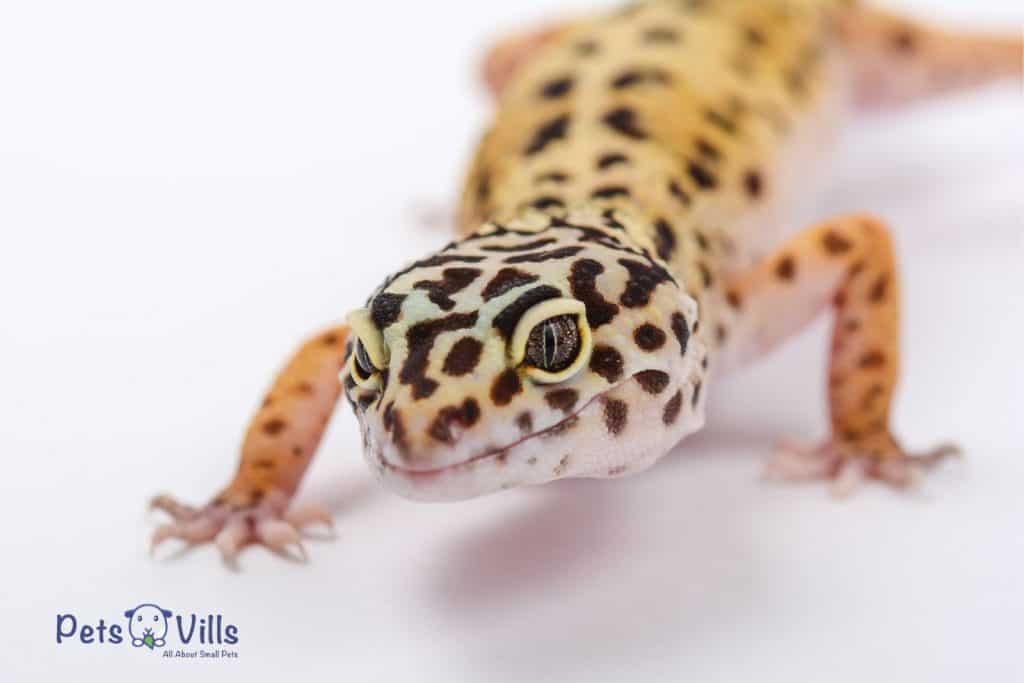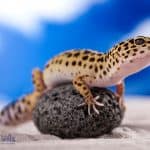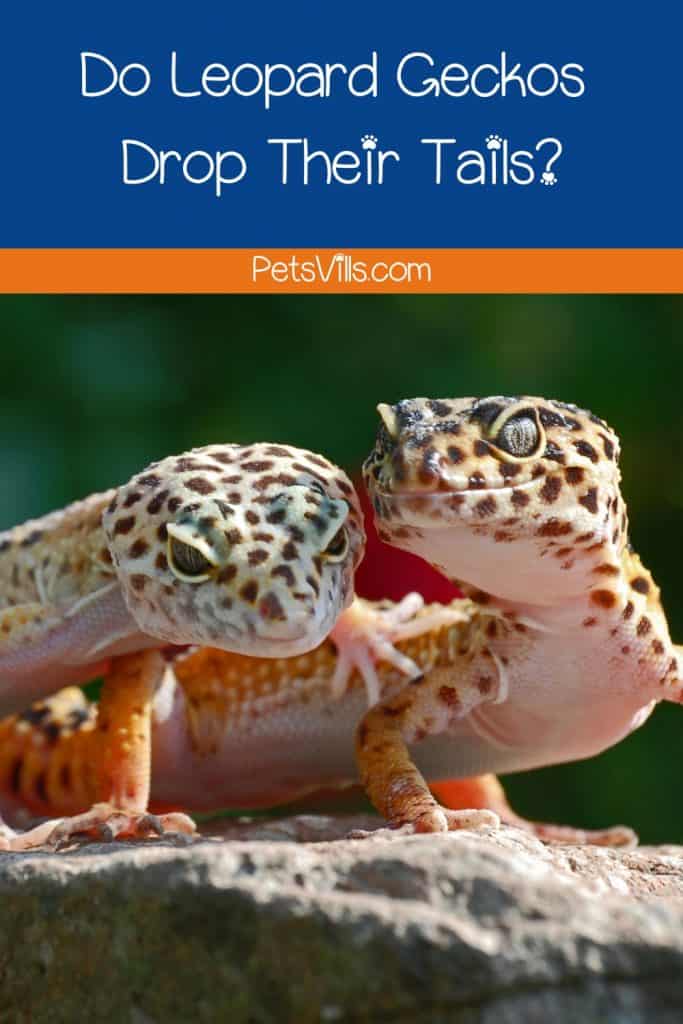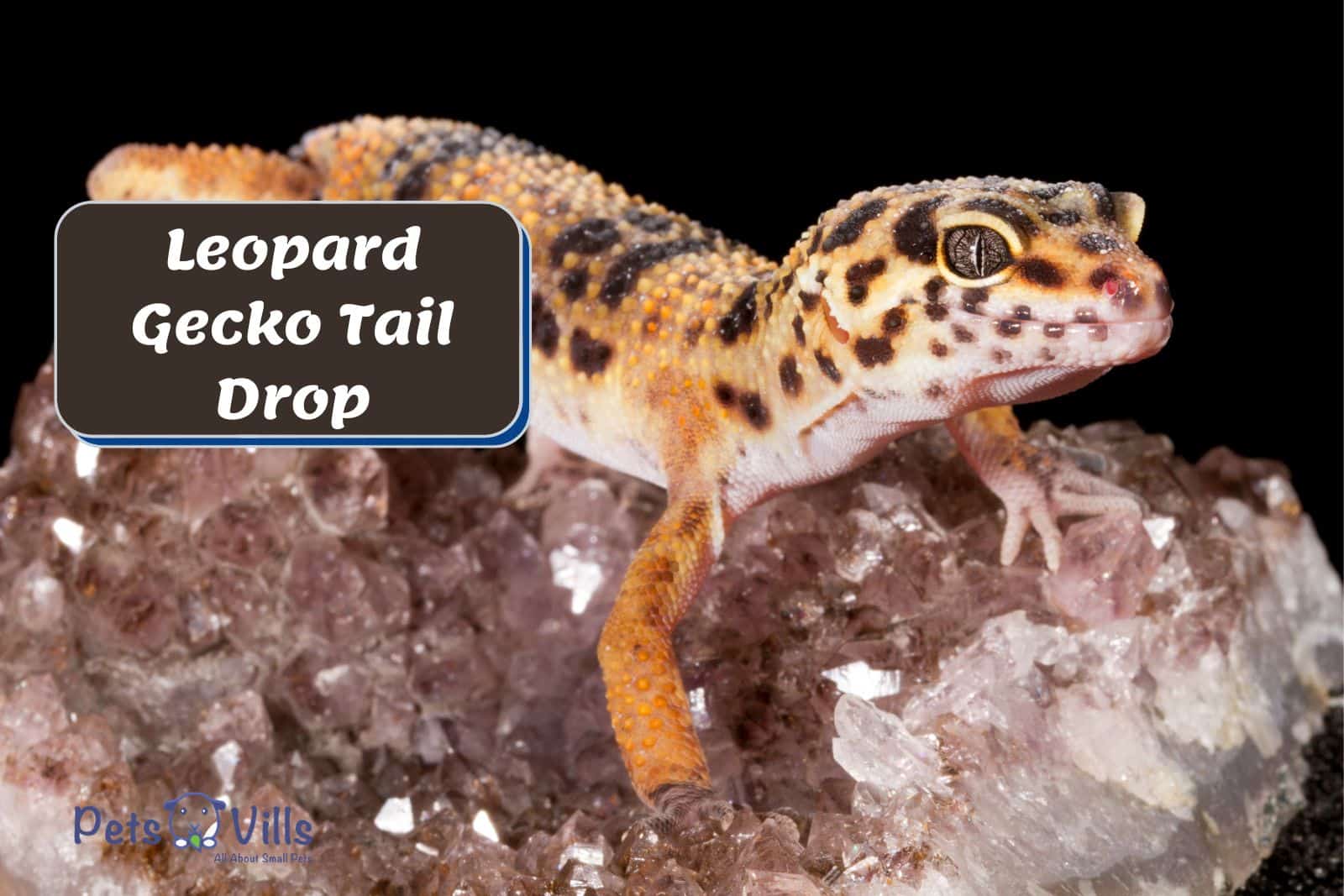Wondering why leopard gecko tail drop happens?
I certainly was when I first witnessed this happen right before my eyes and got worried about my pet.
So I decided to look into it further and spoke to a vet that specialized in reptiles to understand exactly how to deal with specific issues like the tail stump or the detached tail.
And I found that there are so many intriguing facts about the tail drop mechanism in leopard geckos.
Read on to find out!
Table of Contents
Do Leopard Geckos Drop Their Tails?
Yes, but tail-dropping is not exclusive to leopard geckos. It occurs through a process known as autotomy which is a widespread occurrence among several lizard species, geckos inclusive (1)

So what is autotomy exactly, and why do leopard geckos drop their tails?
Autotomy is a defense mechanism in reptiles, allowing them to drop off their tail in a threatening situation. Leopard geckos have significant tail waggle abilities, and the twitching of the detached tail helps to distract the predators for a moment, giving them a chance to escape.
This is a completely natural process, and it occurs more in younger leopard geckos. You may witness it less in adult geckos as they have learned to adapt to their owners and the situations in the environment.
Does It Hurt a Gecko To Lose its Tail?
Tail loss is not painful, but it could result in a stressful experience for your pet, so you should try as much as possible to avoid it.
A leopard gecko’s tail is naturally designed to drop as it’s an adaptive feature built into these wonderful creatures.
There’s a special connective tissue that creates an easy break-off point inside their tail. The blood vessel supplying the tail region constricts to minimize blood loss.
As such, you can quickly tell if a tail loss is natural or is due to trauma.
Let’s take a deeper look at the leopard gecko tail drop.
CHECK: Leopard Gecko Female vs Male
Why Do Leopard Geckos Drop Their Tail?
The main reason leopard geckos drop their tails is that something probably frightens them.
This is why one situation always to avoid when dealing with your pet lizard is handling them by the tail. Exposure to circumstances that can make them frightened, especially while still young, that may result in an attempt to escape increases gecko dropping tail risk.
This was pretty much my experience. I grabbed the tail a little too tightly, and in a flash, the tail came off. Right on the floor was a detached tail, waggling as if it was still connected to the body.
As I’m sure you know, seeing this happen is quite shocking, especially if you don’t fully understand what is happening like I was as a new gecko owner.
A fright isn’t the only reason leopard gecko dropped tail happens. There are others reasons. Let’s take a look at the different circumstances leopard geckos drop their tails
1. Threats
Tail loss is essentially beneficial to wild geckos. In the wild, these reptiles face several threatening situations from natural predators.
Tail dropping is one way to distract potential predators and get away quickly. In captivity, you can also notice tail dropping when there’s bullying between groups in cases where you keep more than one gecko in an enclosure.
2. Stuck Tail
The gecko tail can get stuck in tight corners within the enclosure, which may trigger tail dropping. Ensure you look out for corners that may serve as potential causes of tail loss.
3. Stress and Fear
Environmental conditions such as extreme humidity and temperature, bright light, and loud noises can increase the amounts of stress experienced by these pets leading to tail drop.
4. Illness and Infection
Illnesses with symptoms that can result in extreme stress for the gecko can also lead to tail loss.
Now that we know the reasons, how many times can a leopard gecko lose its tail?
If you’re a leopard gecko owner, you might wonder, “how often do leopard geckos poop?” Our article has all the answers – be sure to check it out!
How Many Times Can a Leopard Gecko Lose its Tail?
The answer to this is dependent on many factors. One question we often ask as reptile owners is if there’s a limit to how many times the tail loss and regeneration cycle can be repeated.
The number of times a leopard gecko can lose its tail depends on how many times it can regrow its tail after a loss. The tail drop will stop only when the tail regeneration no longer happens.
Some leopard geckos lose their tails twice before losing the ability to regrow a new one, while others can go over that cycle multiple times. The cause of the tail loss is a major determining factor in this case.
Traumatic processes such as a severe amputation can cause a gecko to lose its tail regrowth capability permanently. Age could also be another determining factor.
Older geckos may also find it more difficult to regrow their tails than younger ones.
Check out this time-lapse video of leopard gecko tail regeneration.
What Happens When a Leopard Gecko Loses its Tail?
The leopard gecko has to undergo some adaptations to cope with the stress that tail loss creates.
While we have already established that this process is not painful, it is important to mention that it can result in stressful experiences for these beautiful pets.
You should remember that a tail loss leaves the reptile with a tail stump, almost wounded. This mild tail wound may expose your pet to infection risks if left untreated.
Another stressful experience that leopard geckos may undergo during a tail loss is a depletion of their fat reserves. One general way to predict that a reptile suffers from an unhealthy condition is to watch for signs of weight loss.
According to research, most lizards store energy in the fatty tail. (2) When the tail becomes detached, the geckos suffer energy depletion, thereby standing the risk of dying.
Don’t forget to also check out my article on “cute pictures of geckos” for even more adorable gecko photos. You won’t be disappointed!
Do Leopard Geckos Regrow their Tail?
Leopard Geckos can regrow their tail whenever they lose it (3). Although the regeneration process may take close to ten weeks to complete, from 3-4 weeks, you’ll already notice signs of the emergence of a new tail.
If you’re expecting the new tail to resemble the original tail, you might be amazed as you watch the regeneration happen. This is because the regenerated tail doesn’t resemble the one that dropped.
The first time I saw this happen, I was fascinated that not only they could regrow a tail but also that it looked different.
For example, you may find out that the fracture points in the initial and regrown tails are different, even if they are equal in number. The new fracture point is often far from the previous location in the caudal direction.
Another interesting thing about the regrowth process is that the new tail will often be a different color from the previous tail. It will also be blunt and shorter.
It is advisable to prevent your gecko from losing its tail too often, as the quality and strength of the tail keep dropping with each regeneration cycle.
Apart from the tail shortening in length, you’ll also observe that the new tail does not include a bone. The bone is usually replaced with cartilage.
So, you are probably wondering how to care for your pet when it loses its tail. Let’s take a look.
How to Take Care of Your Leopard Gecko When it Loses its Tail?
You should pay attention to your leopard gecko as closely as possible after a tail loss. They go through some level of distress while the tail is regrowing, and you do not want any situation to add to this distress.
Here are some tips for handling your reptile pet after a tail loss.
- Watch out for extreme environmental conditions, including temperature, humidity, light, etc. Ensure that these conditions are regulated as much as possible. Remember that they have just lost a major portion of their energy reserve, and they should not have to stress themselves to generate body heat.
- If you notice weight loss during this period, make sure you improve their diet and ensure they eat more consistently.
- The vivarium environment should be free from impediments. You might also need to put them in a separate tank if you notice bullying from other geckos.
- Do not hesitate to consult your reptile vet if you notice any strange signs during these periods.
You’ll be able to relate to this video. It gives a more visual insight into what we’ve discussed so far.
FAQs
Is a Tailless Gecko Less Valuable?
No, the value placed on them largely depends on the preferences of both the breeder and the intending buyer. A tailless gecko is still as healthy as a tailed one.
Do leopard geckos eat their dropped tail?

While you will certainly find it weird, geckos might eat their dropped tails. This isn’t to hide it, but so they can get back some of their fat stores.
How long does it take for leopard geckos to regenerate their tail
A leopard gecko can regenerate their tails in 30 days, but it can take just over 2 months.
Conclusion
As you can see, leopard gecko tail drop is normal, but it is best to avoid it happening.
When it doesn’t happen, your leopard gecko deserves the greatest care from you at stressful times as a recovery period from a tail loss.
The first step to helping them through this period is to gather as much knowledge as possible about what the tail drop experience entails.

Like me, I hope the tips shared in this article will help you make a better pet owner! Have you experienced leopard gecko tail drop? I’d love to hear about your experiences.
Resources
- 1. Russell AP, Lynn SE, Powell GL, Cottle A. The regenerated tail of juvenile leopard geckos (Gekkota: Eublepharidae: Eublepharis macularius) preferentially stores more fat than the original. Zoology [Internet]. 2015 [cited 2022 Jul 21];118:183–91. Available from: https://www.sciencedirect.com/science/article/abs/pii/S0944200615000161
- 2. Doughty P, Shine R, Lee MSY. Energetic costs of tail loss in a montane scincid lizard. Comparative Biochemistry and Physiology Part A: Molecular & Integrative Physiology [Internet]. 2003 [cited 2022 Jul 21];135:215–9. Available from: https://www.sciencedirect.com/science/article/pii/S1095643303000874
- 3. Delorme SL, Lungu IM, Vickaryous MK. Scar-Free Wound Healing and Regeneration Following Tail Loss in the Leopard Gecko,Eublepharis macularius. The Anatomical Record: Advances in Integrative Anatomy and Evolutionary Biology. 2012;295:1575–95.
Alina Hartley is a small-town girl with a ginormous love of bearded dragons. It all started with Winchester, a baby bearded who was abandoned at the shelter by his former owners because of a birth defect that caused one front leg to be shorter than the other. Alina originally went to the shelter looking for a guinea pig, but one look at Winchester and it was love at first sight. From that day on, Alina has dedicated her life to learning everything she can about bearded dragons. She loves helping new beardie parents start their incredible journey with these magnificent reptiles.
Follow her on:
LINKEDIN
TWITTER.
Read her latest articles HERE
Learn more about her HERE.



![Leopard Gecko Poop: What’s Normal & What’s Unhealthy [7 Types]](https://petsvills.com/wp-content/uploads/2022/09/Leopard-Gecko-Poop--211x150.jpg)